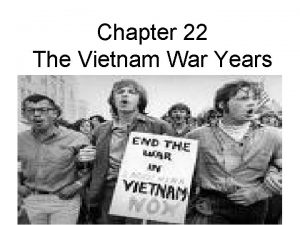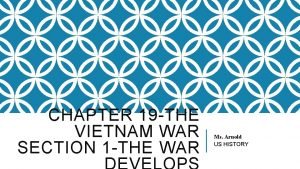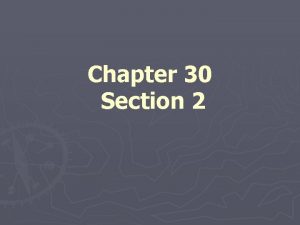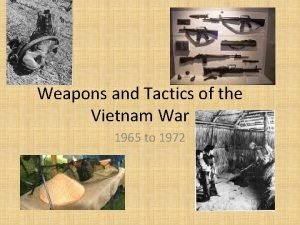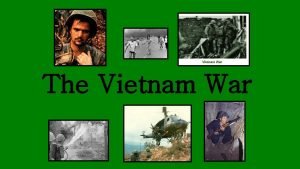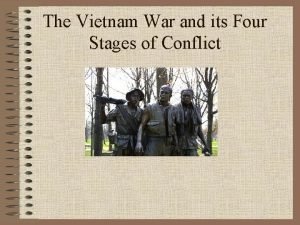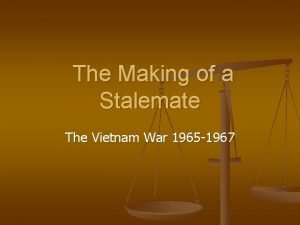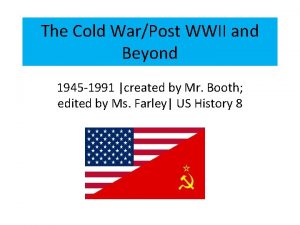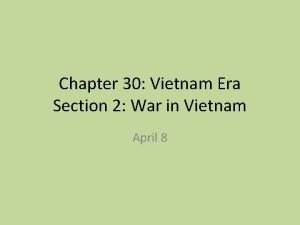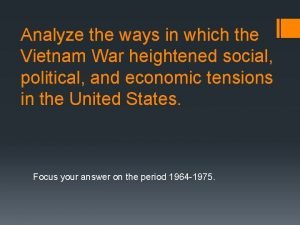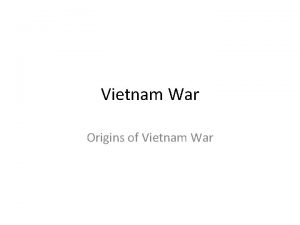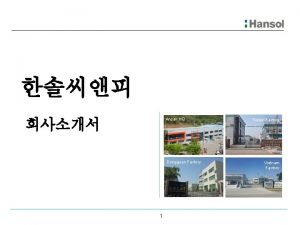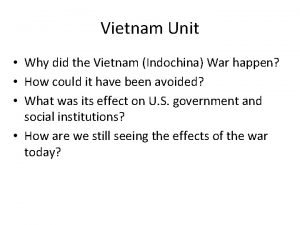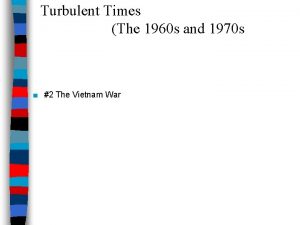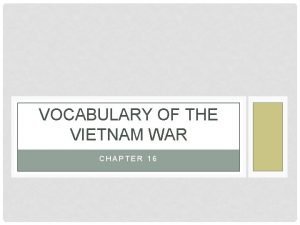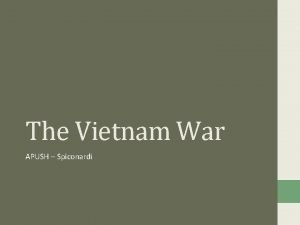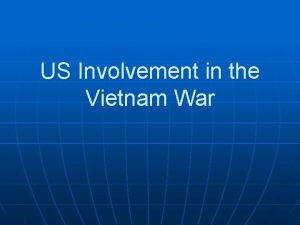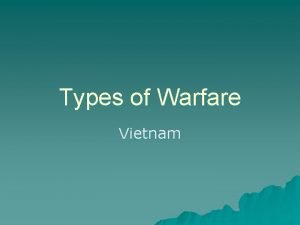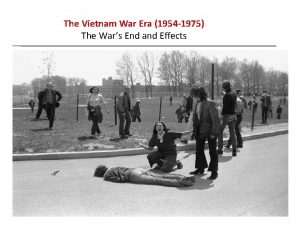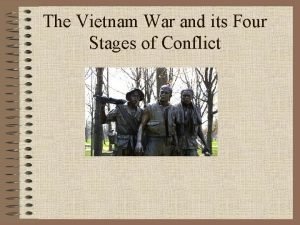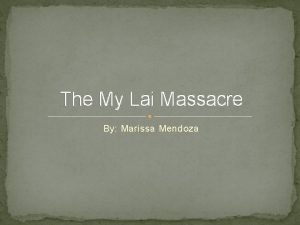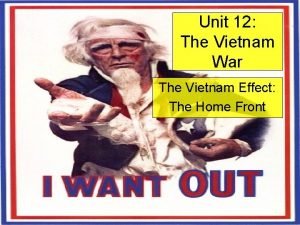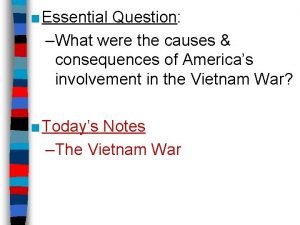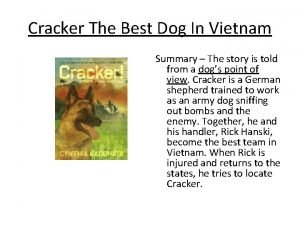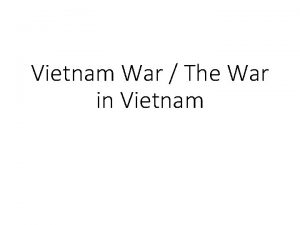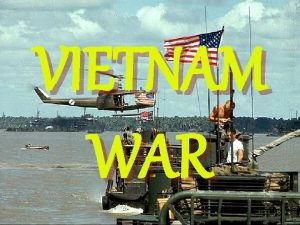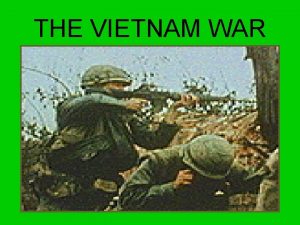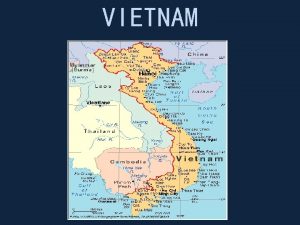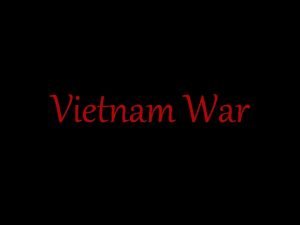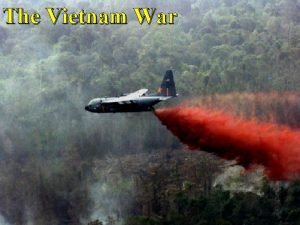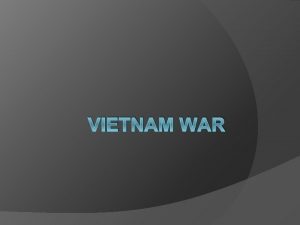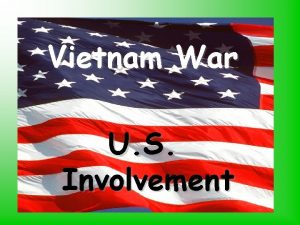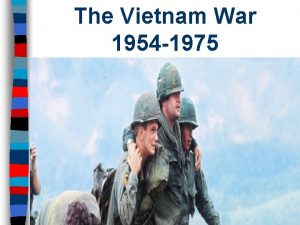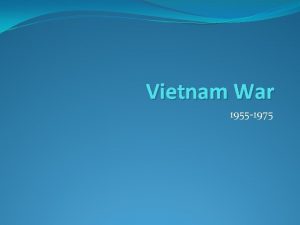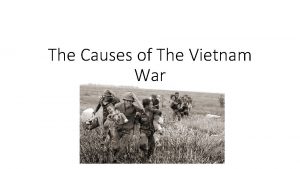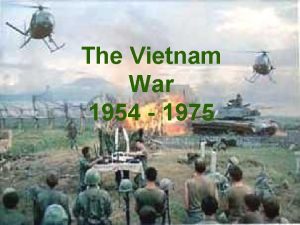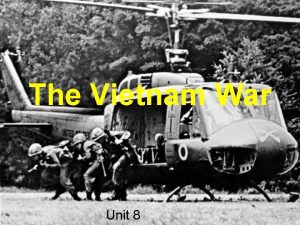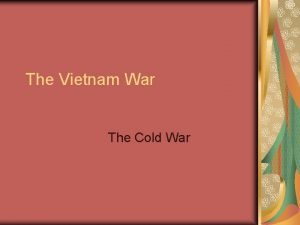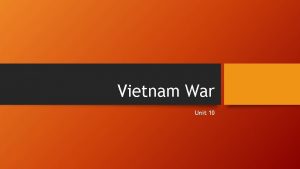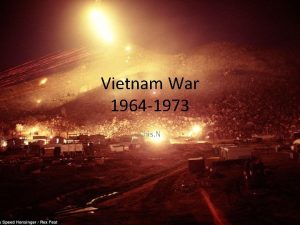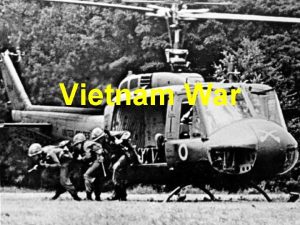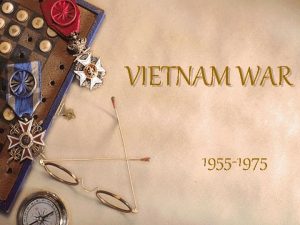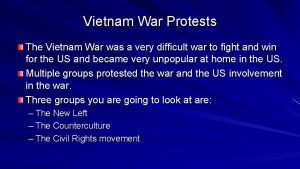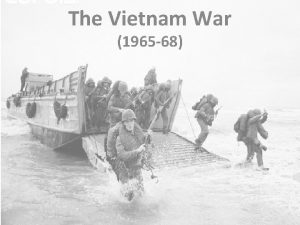The Vietnam War CHAPTER 22 THE VIETNAM WAR









































- Slides: 41

The Vietnam War CHAPTER 22

THE VIETNAM WAR � 20 years � Five presidents � 164 billion dollars � 58, 132 Americans died/2 million Vietnamese � 150, 000 Americans wounded � 21, 000 permanently disabled � 3 million Americans served (avg. age 19) � 100, 000 fled U. S. to avoid conflict � 830, 000 PTSD reports

VIETNAM WAR � U. S. had the latest military technology � Could not defeat a poorly equipped peasant army � Why not? ? � Vietnamese fighting for their independence � Very difficult conditions to fight under (enemy, weather, terrain, etc)

CAUSES OF VIETNAM WAR � Depends on who you ask……………. � Americans— � Cold War � Stop spread of communism � Domino Theory � Political reasons

CAUSES OF VIETNAM WAR � Vietnamese— � Imperialism � Western greed � Resources � Desire for independence/self rule � Internal Civil War

HISTORY OF VIETNAM � Nearly 2000 years old � Imperialized for nearly all its existence � China controlled Vietnam for 1, 000 years � Referred to the area as Indo China (Vietnam, Laos and Cambodia) � 1858 Vietnam occupied by France � 1940 Vietnam occupied by Japan � 1945 Vietnam reoccupied by France

INDOCHINA

INDOCHINESE COMMUNIST PARTY Formed in 1930 � Leader: Ho Chi Minh (he who enlightens) � Planned for Vietnam’s independence movement � Group combined with other nationalist groups and became the Vietminh �

VIETMINH Vietnamese Nationalists � Determined to gain independence � France had no intention of giving up its rule � Pres. Truman sent 15 million in aid to France � Eventually paid for most of France’s war (2. 6 billion) to defeat Vietminh �

FRANCE DEFEATED Dien Bien Phu falls to Vietminh � May, 1954 France surrenders and pulls out of Vietnam � Despite massive U. S. aid �

GENEVA ACCORDS May-July 1954 � Meeting in Geneva, Switzerland � France, G. B. , S. U. , U. S. , China, Laos, Cambodia, Vietminh, S. V. anti-communists � Agree to temporarily divide Vietnam at 17 th parallel until elections held in 1956 �

DIVISION OF VIETNAM Communist North Vietnam under Ho Chi Minh (Hanoi Capital) � Anti-Communist South Vietnam under Ngo Dinh Diem (Saigon capital) � Elections to be held in 1956: let the people decide who they want to lead Vietnam �

TIME FOR ELECTION Ho very popular (land reforms) � Diem hated by many (anti-Buddhist) � Very corrupt, oppressive gov’t. � Diem cancels elections in 1956 �

GUERILLA WARFARE Vietcong (Communist group formed in South Vietnam) � Teamed up with Vietminh in North Vietnam to fight against Diem’s Army � U. S. assisting Diem (military advisors, financial aid, etc. ) �

1963: A VERY BAD YEAR Diem’s army near defeat to communists � Nov. 1, 1963: Diem assassinated (military coup) � Nov. 22, 1963: Kennedy assassinated � JFK said “in the final analysis, it’s their war” �

LYNDON JOHNSON’S VIETNAM � � Communists close to uniting Vietnam under one rule LBJ does not want to be perceived as “soft on communism” Election of 1964 approaching in U. S. Appoints Gen. William Westmoreland as commander of U. S. forces in S. V.

AM. SOLDIERS COMMITTED TO COMBAT Gulf of Tonkin Incident � Aug. 2, 1964 � LBJ accuses N. V. of an unprovoked attack on USS Maddock patrolling off coast of Vietnam � “alleged” attacks prompted Johnson to strike back �

GULF OF TONKIN RESOLUTION Aug. 7, 1964: Congress adopts this resolution (close to a declaration of war) � Gave Johnson the power to take “all necessary measures to repeal any armed attack against U. S. forces” �

OPERATION ROLLING THUNDER Feb. 1965: first sustained bombing of N. V. � U. S. air force conducted avg. of 5, 500 bombing missions per month � Goal: break N. V. will to fight and force a surrender �

THE WAR ESCALATES June 1965: 50, 000 U. S. soldiers in S. V. � Gen. Westmoreland asks for more soldiers to assist S. V. (ARVN) � 1965: 61% Ams. Support the war/24% oppose it � Johnson told we could win the war in 2 yrs. Max. �

WAR ESCALATES 1967: 500, 000 U. S. troops in Vietnam � Death toll at 9, 000 Ams. � Johnson pledged that victory is near � Westmoreland’s strategy for defeating Vietcong: destroy their morale. Introduced “body count” �

A DIFFICULT WAR TO FIGHT � Guerilla warfare (no front lines) � Jungle terrain � Landmines, booby traps, underground tunnels, heat, rain, leeches, secret supply routes � Hit-n-run tactics � Difficult to identify the enemy � Underestimated the enemy’s resolve to fight

DIFFICULT CONDITIONS Vietcong aided by China and Soviet Union � Televised war (little censorship) � High drug use and addiction � Racism among troops � Heavy use of chemicals (agent orange, napalm) �

AMERICAN SUPPORT DECLINES 1967: morale low among soldiers � Public support waivers � Credibility gap growing � Active protests on college campuses � Thousands searching for ways to avoid the draft (ages 18 -26) �

ANTI-WAR PROTESTS College campus demonstrations increasing � Musicians singing antiwar songs � Burning draft cards � Conscientious Objectors (opposed war on moral or religious grounds) �

1968: A TUMULTUOUS YEAR! Jan. 30, 1968: Tet, the Vietnamese New Year was traditionally celebrated by a ceasefire. � Instead 80, 000 NVA + Vietcong launched an attack on key cities in S. V. , 12 Am. Bases, & U. S. Embassy. �

RESULTS OF TET OFFENSIVE Four weeks of fighting to regain control of areas in S. V. � Vietcong deaths: 32, 000 � U. S. & ARVN deaths: 3, 000 � Military victory � Psychological defeat �

� � Polls showed a majority of GAP GROWS Ams. CREDIBILITY No longer supported Johnson’s policies in Vietnam Johnson had 60% disapproval rating Sect. State Mc. Namara resigned Media openly criticizing the war now WALTER CRONKITE EFFECTS OF TET OFFENSIVE

PRESIDENT JOHNSON’S ANNOUNCEMENT Mar. 31, 1968: “I shall not seek and I will not accept the nomination of my party for another term of President” � V. P. Hubert Humphrey announces his candidacy for Demo. Party �

2 MAJOR ASSASSINATIONS: � � DEMOCRATIC NATIONAL CONVENTION April 4: Martin Luther King assassinated in Memphis, Tennessee June 4: Robert Kennedy, top contender for Presidency in 1968, assassinated in Los Angeles Hotel 1968: A VERY BAD YEAR

DEMOCRATIC NATIONAL CONVENTION 1968 � � � Held in Chicago (Aug) Several democratic candidates seeking the nomination 10, 000 protestors showed up. Wanted democrats to adopt antiwar platform Students for a Democratic Society (SDS) Yippies (Youth International Party)

RESULTS OF CHICAGO RIOTS Riots broke out in Chicago � Mayor of Chicago ordered 12, 000 police officers and 5, 000 national guardsmen � Images captured made Democrats look bad. � Nixon (Rep. ) triumphs from this �

ELECTION OF 1968 � Hubert Humphrey: Demo. Candidate (V. P. under Johnson) � Richard Nixon: Republican Candidate (V. P. under Eisenhower) � George Wallace: Am. Independent Party (Gov. Alabama) Ran on platform of school segregation and state’s rights

ELECTION OF 1968

ELECTION OF 1968

HUBERT HUMPHREY ELECTION OF 1968 GEORGE WALLACE

ELECTION OF 1968

NIXON’S WAR � Nixon won by 800, 000 more votes � Promised “an honorable end to the war” � “Peace with Honor” � Announces his “Vietnamization Plan”: gradual withdraw of U. S. troops in order for S. V. army to take control of war � Goal was to maintain dignity in face of withdraw from war

PROTESTS CONTINUE College campuses continue to protest the war � Nixon hates these protests (hippies) � Appeals to “the silent majority”: moderate, mainstream Americans who quietly supported the president’s strategies. �

MY LAI MASSACRE Nov. 1969 New York Times reported on incident that occurred in March, 1968 � Charlie Company (120 men) under Lt. William Calley, Jr. entered small village in northern S. V. � Orders to kill everyone in village (Vietcong rebels) �

MY LAI MASSACRE No signs of Vietcong in village � Carried out the orders and proceeded to kill over 500 villagers (old men, women, children) � Lt. Calley charged and convicted of war crimes (Nixon reduced sentence to 3 yrs. House arrest) �
 Vietnam war
Vietnam war Sclc and sncc venn diagram
Sclc and sncc venn diagram The vietnam war years chapter 22
The vietnam war years chapter 22 Chapter 19 the vietnam war
Chapter 19 the vietnam war Chapter 30
Chapter 30 Us weapons vietnam war
Us weapons vietnam war Results of the vietnam war
Results of the vietnam war Stages of the vietnam war
Stages of the vietnam war Did the vietnam war end in a stalemate
Did the vietnam war end in a stalemate Civil war digging deeper webquest answers
Civil war digging deeper webquest answers Space bar
Space bar Analyze the ways in which the vietnam war heightened social
Analyze the ways in which the vietnam war heightened social Vientcong
Vientcong Vietnam war
Vietnam war Napalm vietnam war
Napalm vietnam war Vietnam war 1960
Vietnam war 1960 Vietnam war vocabulary
Vietnam war vocabulary Vietnam war apush
Vietnam war apush Vietnam
Vietnam Punji trap victim
Punji trap victim Reason for vietnam war
Reason for vietnam war Effects of the vietnam war
Effects of the vietnam war Stages of the vietnam war
Stages of the vietnam war Marissa lai
Marissa lai Pro vietnam war slogans
Pro vietnam war slogans What were the causes and effects of the vietnam war
What were the causes and effects of the vietnam war Chapter 30 the war to end war
Chapter 30 the war to end war Chapter 30 the war to end war
Chapter 30 the war to end war Cracker the best dog in vietnam chapter summaries
Cracker the best dog in vietnam chapter summaries War at home and abroad madison
War at home and abroad madison Lesson 1 the cold war begins
Lesson 1 the cold war begins Was josette dugas pro war
Was josette dugas pro war Ich war, du warst
Ich war, du warst Force and motion study jams
Force and motion study jams Why was the civil war considered the first modern war
Why was the civil war considered the first modern war Ich war du warst er war
Ich war du warst er war Chapter 16 lesson 2 challenges to slavery
Chapter 16 lesson 2 challenges to slavery Cold war sides
Cold war sides Hát kết hợp bộ gõ cơ thể
Hát kết hợp bộ gõ cơ thể Ng-html
Ng-html Bổ thể
Bổ thể Tỉ lệ cơ thể trẻ em
Tỉ lệ cơ thể trẻ em


